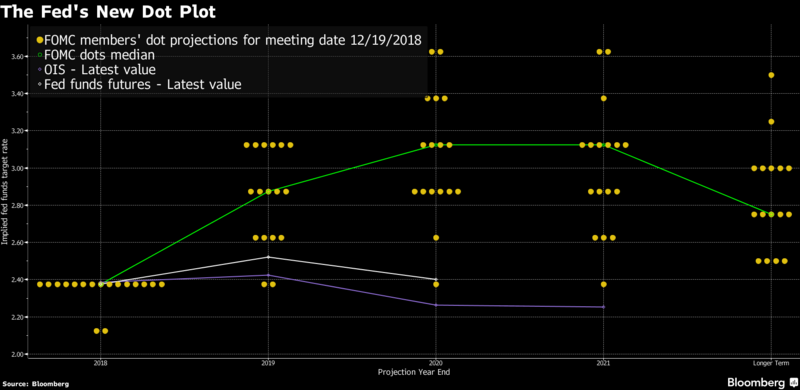The Daily Dish
March 19, 2019
Next Steps for the Fed
Eakinomics: Next Steps for the Fed
The Federal Open Market Committee (FOMC) begins a 2-day meeting today that will be capped off by a statement, economic forecasts, and interest-rate projections tomorrow at 2:00 p.m. and a press conference by Fed Chairman Jerome Powell a half-hour later.
Of primary importance is the outlook for the economy, which has suffered somewhat recently from slowing growth, fluctuations in consumer confidence and business investment, and chaotic fiscal (e.g., government shutdowns) and trade policies. But coming in a close second will be the outlook for future interest rate hikes (or not), as summarized by the so-called “dot plot” that summarizes 19 individual projections for interest rates. Each dot is one member’s expected value of the federal funds rate – the policy rate – in the future. The dot plot from December is reproduced below (thanks to Bloomberg for providing a readable version).
The dot plot was introduced in 2011 as a way to provide guidance to financial markets about the future of interest rates, reduce policy uncertainty, and convey the Fed’s intention to keep rates low (zero, actually) in the aftermath of the financial crisis.
Now that the Fed has gotten back into the business of raising rates, the dot plot has moved from an effective tool of communication to a potential source of confusion. The essence of the problem is this: what does the plot above tell us about the future of the federal funds rate? It has been common to interpret the median of the projected rates (the green line, above) as “the” Fed forecast.
In December, this implied two more rate increases in 2019. However, only 3 members would have to cut their projections to reduce the median to one rate increase; 7 changes put the median at standing pat. Would it really be accurate to say that “the Fed” changed its outlook if only 3 of 19 people did so?
The outcome of the Fed meeting will be of greater than average interest. But it is probably more important to listen to what the statement and Chairman say than to ponder the dots too closely.
Fact of the Day
Since January 1, the federal government has published $16.5 billion in net costs (with $8.8 billion in finalized costs) and 22.9 million hours of net paperwork burden increases (including roughly 24.2 million hours from final rules).











